Last updated on September 3rd, 2024.
We’re doing it; today, we are learning how to make Choux Pastry and answering all your questions about this French pastry. The good news is that we will cover every aspect , so this is a long post; the even better news is that we will cover my absolute favorite part: the Baking Science part.
I’ve arranged the structure of the post in a way that you can read it however it suits you; you can start from the top and work your way down if you want to become a Choux pastries master or skip to parts you find most intriguing.
What is Choux Pastry?
In french, choux means cabbage because it resembles little cabbages baked into classic cream puffs. Due to the hollow interior structure and its somewhat bland flavor, Choux pastries are vessels for many flavors and fillings. It is called choux pastry dough when the truth is that it is a cross between the dough and a batter. It is stable enough to keep its form when piped but too sticky to be kneaded and handled by hand. These qualities are why many bakers use the term paste.
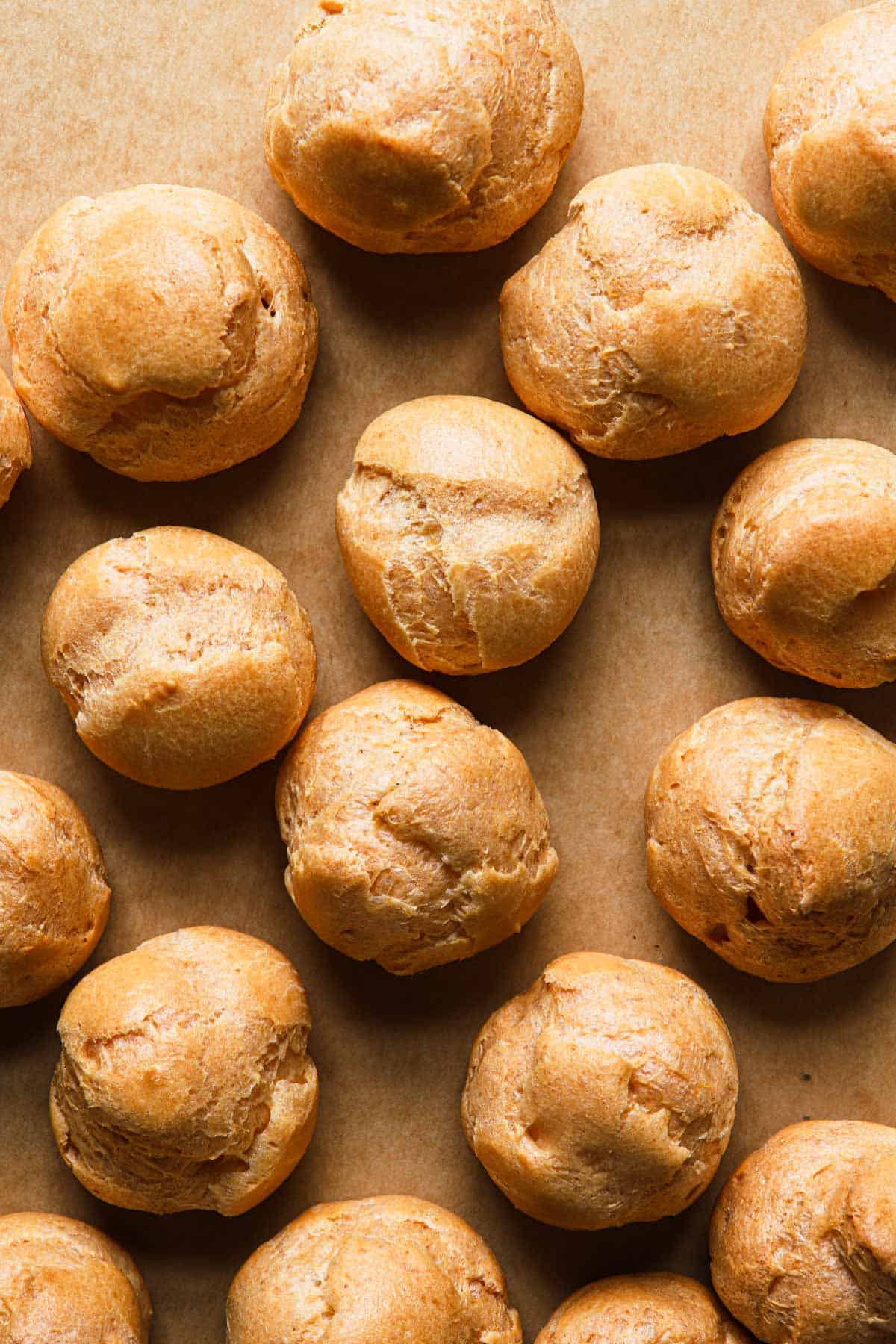
Choux Paste variations and uses
Choux paste is a multifunction wonder and is the base for many popular desserts such as:
Profiterole and cream puffs – both are piped into a ball and filled. While profiteroles can be filled with anything: ice cream, sweet cream, stabilized whipped cream, and even savory fillings like cheese puffs, cream puffs are filled with sweet creams, like this Choux a la creme recipe, filled with Creme Legere, creme chiboust, or creme mousseline.
Eclairs – choux dough baked as a log, filled with cream, and dipped with chocolate ganache.
French crullers donuts – the paste is piped into a ring shape, then fried and dipped into a thick sweet glaze.
Churros – long logs fried in deep oil and then coated with cinnamon sugar.
Choux un craquelin – profiteroles pr cream puffs topped with a sweet cracker.
Chouquetts – the raw dough is topped with pearl sugar for added sweetness and texture.
Paris Brest – a ring-shaped choux pastry topped with almonds and filled with cream.
Croquembouche – small cream puffs piled into a tall cone. The pastries are dipped in caramel and swirled with crispy caramel threads.
Karpatka. A Polish classic mountain cake made of two layers of choux cakes and filled with cream.
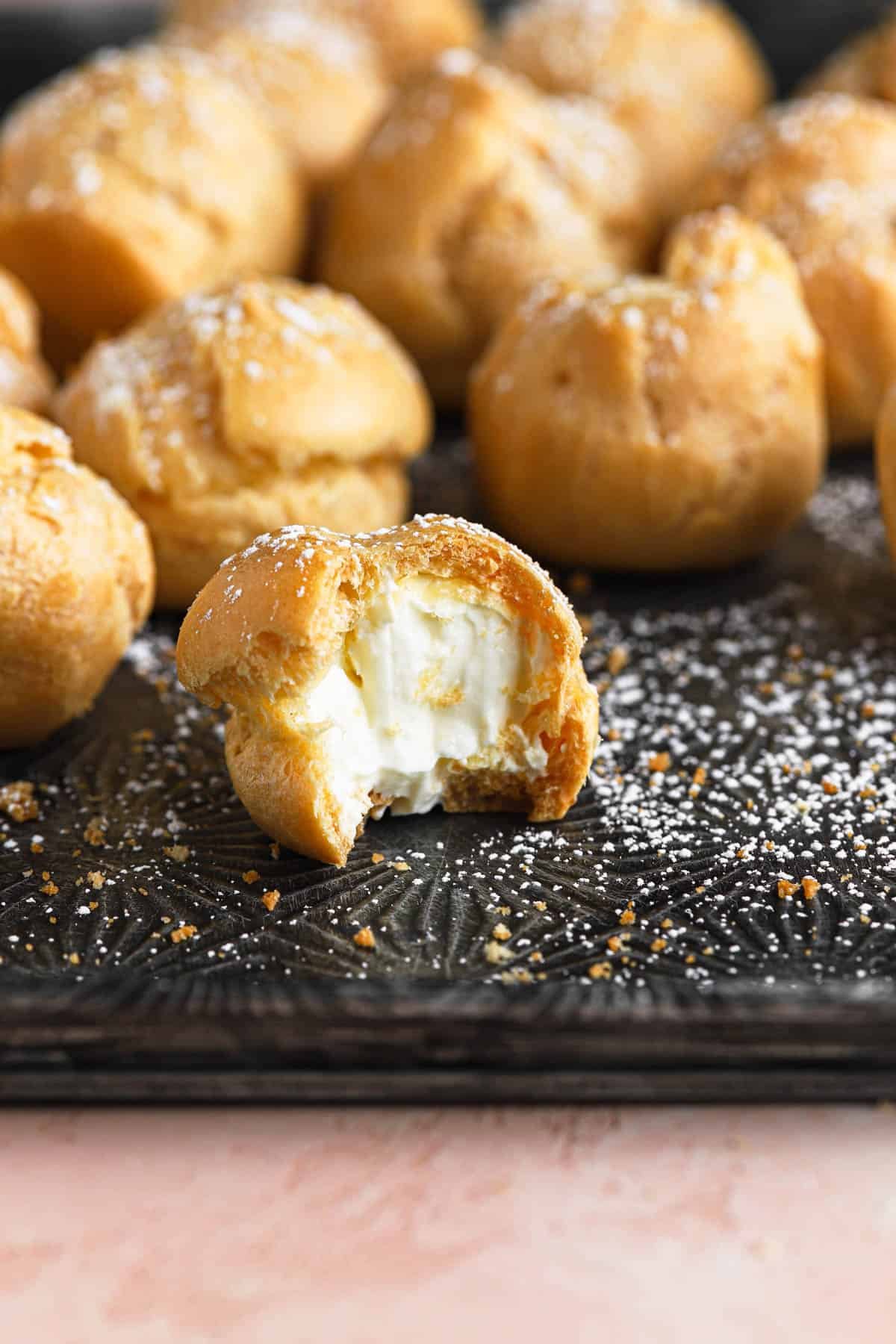
The Science Of Choux Pastry
Please remember that although this is science, it is not rocket science, and after reading this paragraph, you will have a deep understanding of what and how to make the perfect choux pastry every time.
The perfect choux bun is light and puffy with a hollow interior. While its shell is sturdy enough to stretch without tearing, like a bread crust, it is also tender and pleasant to bite, like a buttery cake.
The fascinating thing about choux pastry is that it doubles its size during baking even though there is no chemical (baking powder, baking soda) or biological (yeast) leavening in the dough. A high moisture content is incorporated into the paste in a unique two-step mixing method that gives it its famous puffy quality.
Choux Pastry ratio
2 parts water :1 part butter: 1 part flour: 2 parts eggs.
This ratio is for grams and oz only; keep this ratio in mind when and when you wish to change the recipe. For example, the ratio is critical to the success of our french pastry dough: If we decide to use shortening instead of butter, we need to use 80% butter because it is 20% water.
The egg’s amount might vary depending on variables such as how long you cooked the dough, climate, and moisture in your kitchen. Read more to see how to tell if you need to add more eggs to your cabbage pastry.
Making the Panade
Panade is the term that refers to the process of cooking and thickening starches; for example, pastry cream or, in our case, choux pastry. We bring liquid and melted fat to a boil, add the flour, and cook until it reaches 175F. This step is how we achieve the perfect balance of sturdy, stretchy, tender, and delicate shells. First, the melted fat coats the flour granulates and minimizes the formation of tight gluten chains. Second, as the temperature rises, the starch molecules bounce around and absorb the liquids, and later during baking, they will release long chains that will coagulate (form a net) with each other and build a stable structure.
Cooking the panade to 175F
Many professional bakers cook the panade to a 175F (79C), and there are two main reasons for that:
- Starches released into liquid immediately absorb it. At a temperature of 140F 60C, they swell and absorb even more liquid as they move around. But the gelatinization begins at a temperature of 204F (85C) when the starches release long chains that bond with each other and provide stability to the dough. Cooking the panade to 175F (79C) is finding the sweet spot between allowing the starches to reach maximum absorption without getting to the final gelatinization.
- An enzyme called amylase in the starches tends to disturb them and break their structure. At a temperature of 170F 76C, the enzyme is inactivated.
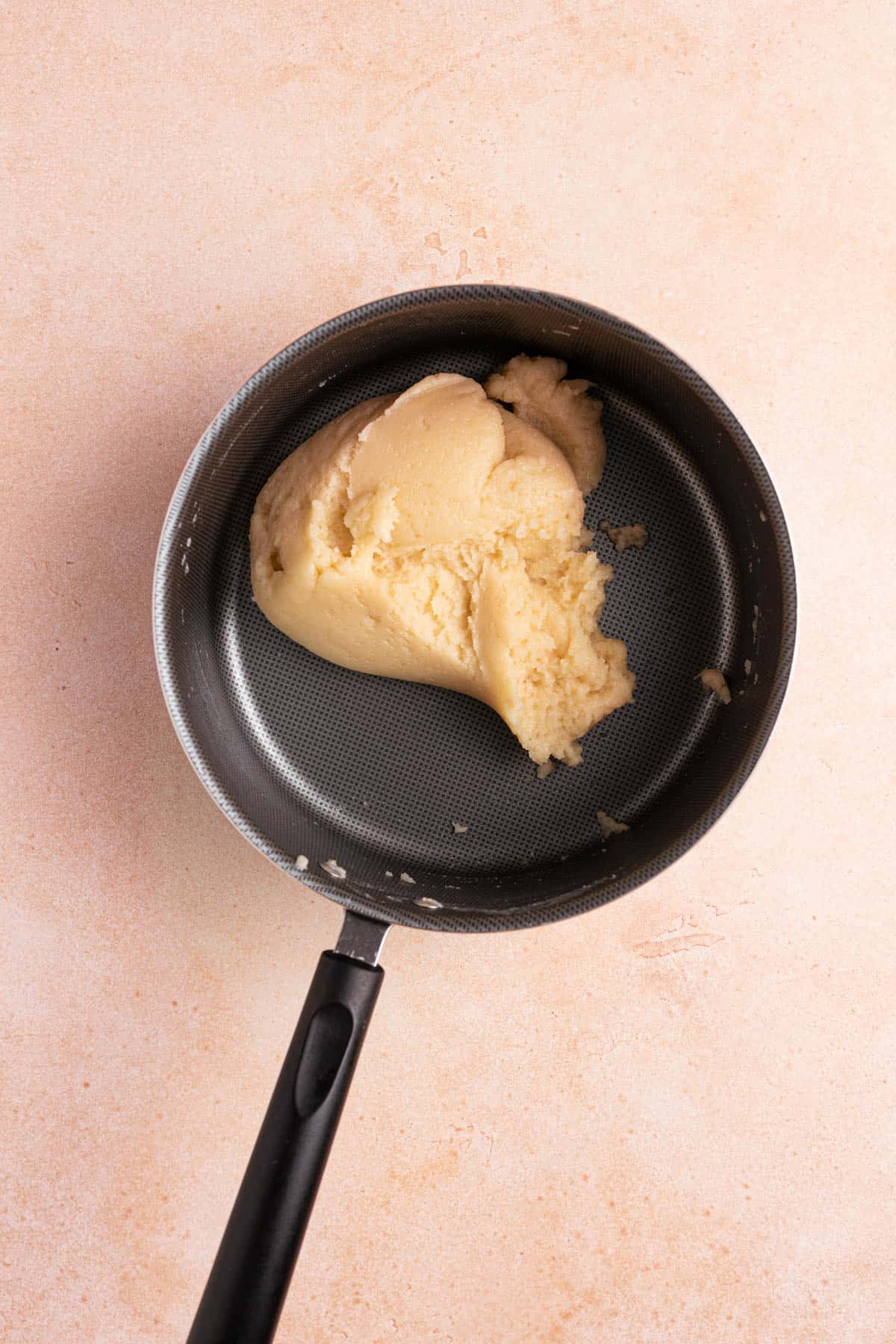
The eggs role
The yolk is approx. 80% fat and will contribute to the tender texture of the pastry. But egg whites can stretch and expand. They expand and stretch as the steam expands, puffing the pastry. However, because the steam pressure is consistent, it eventually breaks the structure, giving the signature hollow interior.
And because it is exposed to heat directly, the egg whites tend to set faster and can resist the pressure from evaporation.
Oven Temperature
Know your oven. The correct temperature is necessary to achieve perfectly puffed pastries. If the temperature is too low, there might not be enough pressure to stretch and puff the pastries, and we will end up with small or flat ones. If your oven runs too high, the pressure from the evaporation is too abrupt and will break the shell and give it an even appearance. Or, they will set fast before the steam has a chance to evaporate and turn out flat with no hollow.
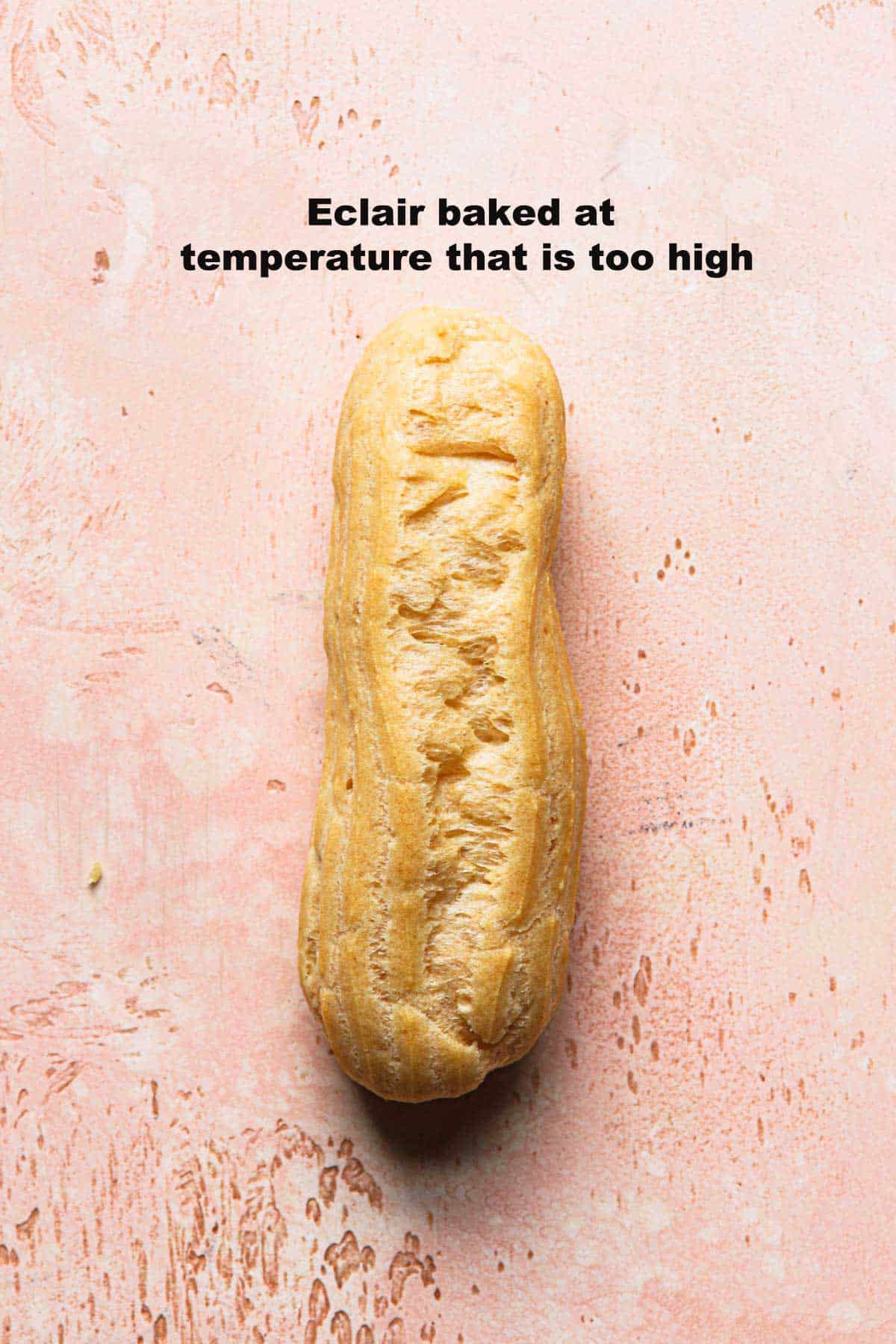
Choux Ingredients
You only need four ingredients to make this versatile pastry dough:
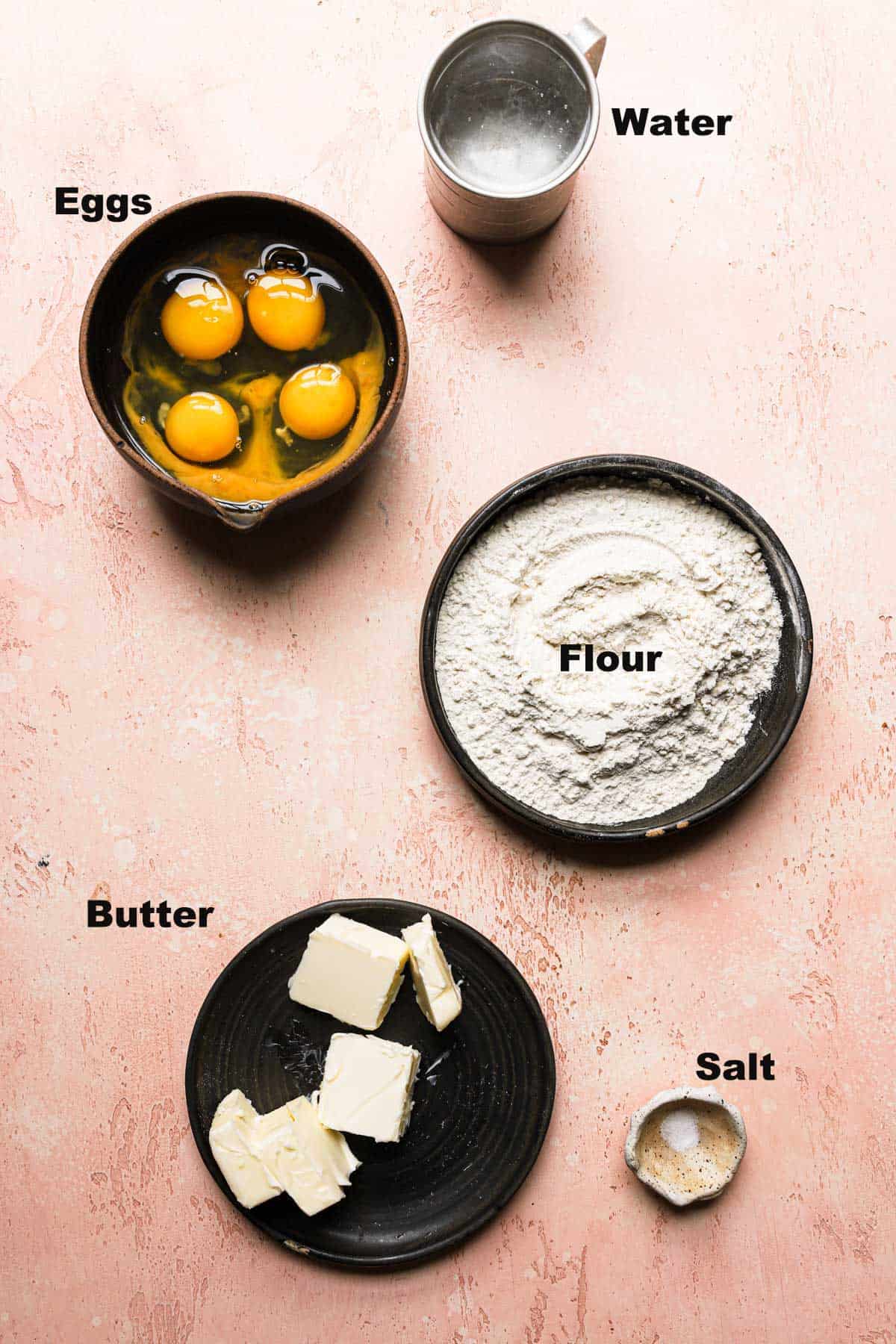
- Liquid. You can use water, milk, or a combination of water and milk. The most common question is if we can use milk when making choux puffs. And the answer is yes, but the result will vary. Firstly, the milk will contribute to the browning of the pastries. Secondly, because milk’s boiling temperature is higher than water, evaporation will start later, resulting in a less puffy pastry with fewer hollows.
- Butter. Or your choice of fat oil, shortening, vegetable oil, margarine, and even vegan butter will work just fine. Keep in mind that butter provides a unique flavor that non of us cannot compare. Also, butter is about 4% milk solids, which like milk, contribute to the browning.
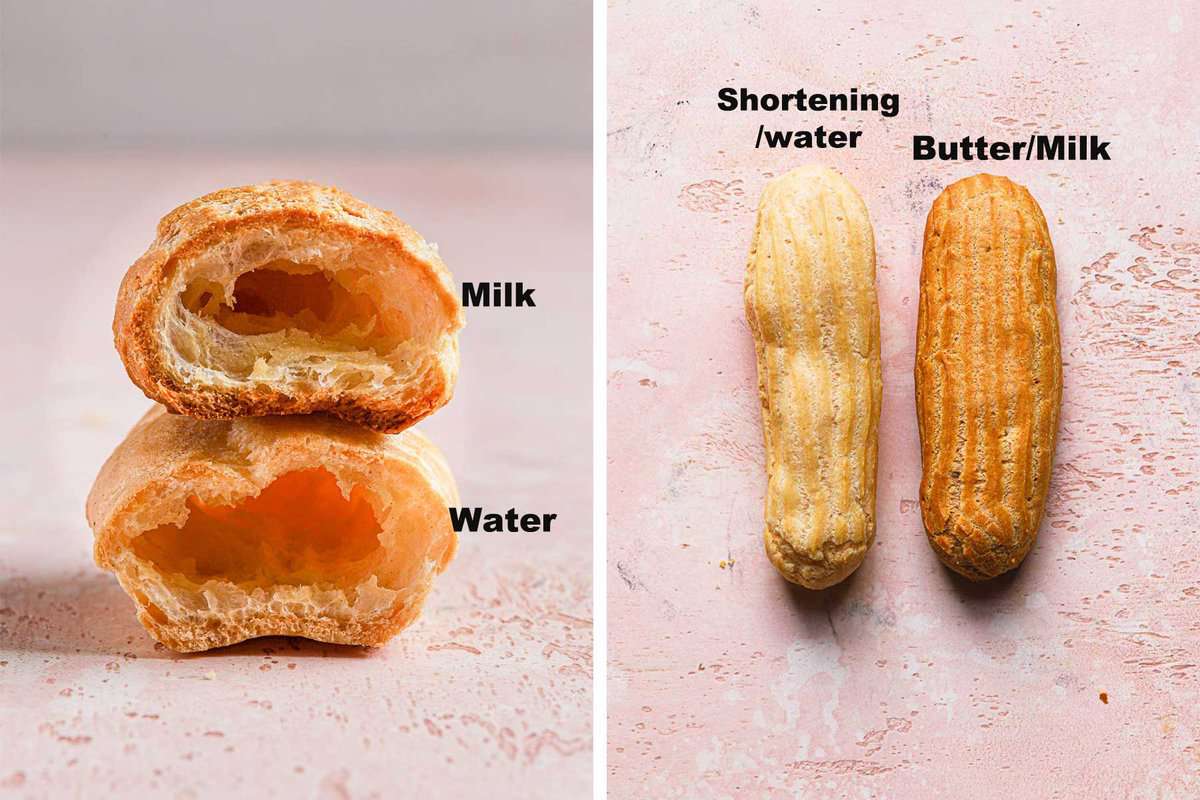
- Flour. Bread flour and unbleached all-purpose flour are both great options. The amount of gluten in the flour and its strength keep the sturdy form of the shells. The gelatinized starch is not enough to maintain balance. Avoid using bleach, cake, pastry flour, or self-rising flour. Check out my Pretzel Cream Puffs, for a surprising flour subsitution.
- Whole Eggs. Most recipes call for large eggs weighing 55 grams each in the states. Whenever possible, weigh your eggs before adding them to the dough. And always bring them to room temperature before use.
- Salt (optional). Even though it helps with flavor, it also strengthens the flour. It can be added if using unsalted butter, but ensure it is no more than 1% of the liquid. Too much salt will strengthen the gluten, and the pastry will not rise.
How to make Choux Pastry, by hand or using a stand mixer
Start by measuring your ingredients and bringing them to room temperature. You can make it by hand, using an eclectic or stand mixer.
Time needed: 45 minutes
- Make the panade:
In a medium saucepan, place the water (or milk), salt, and butter, cut into pieces and bring to a boil over medium heat. Once it reaches boiling point, add the flour and use a wooden spoon to stir while cooking to a temperature of 175F (79C). The dough should look like a smooth ball, and if you do not have a thermometer, cook the panade for about 2 minutes until it leaves a thin layer of cooked flour at the bottom of the pan.
- Remove from heat
and place the dough in a bowl of a stand mixer or a large mixing bowl. Use the paddle attachment or a spoon to mix the dough on medium speed and cool it down. It is ready when you no longer notice steam coming out of the dough.
- Mix the eggs
in a large measuring cup, drizzle them into the bowl on medium speed in four batches (about 60 g, or one egg at a time). Once you add the third portion of the eggs, stop the mixer and check the consistency of the dough. It is done if it forms a “v” shape when it drips down from the spatula. If it is too thick, then add the last egg portion. This will be a food indication of whether you added enough or too much flour.
- Fill a large piping bag
Then pipe the choux over a baking tray lined with parchment paper or silicon mat and bake.
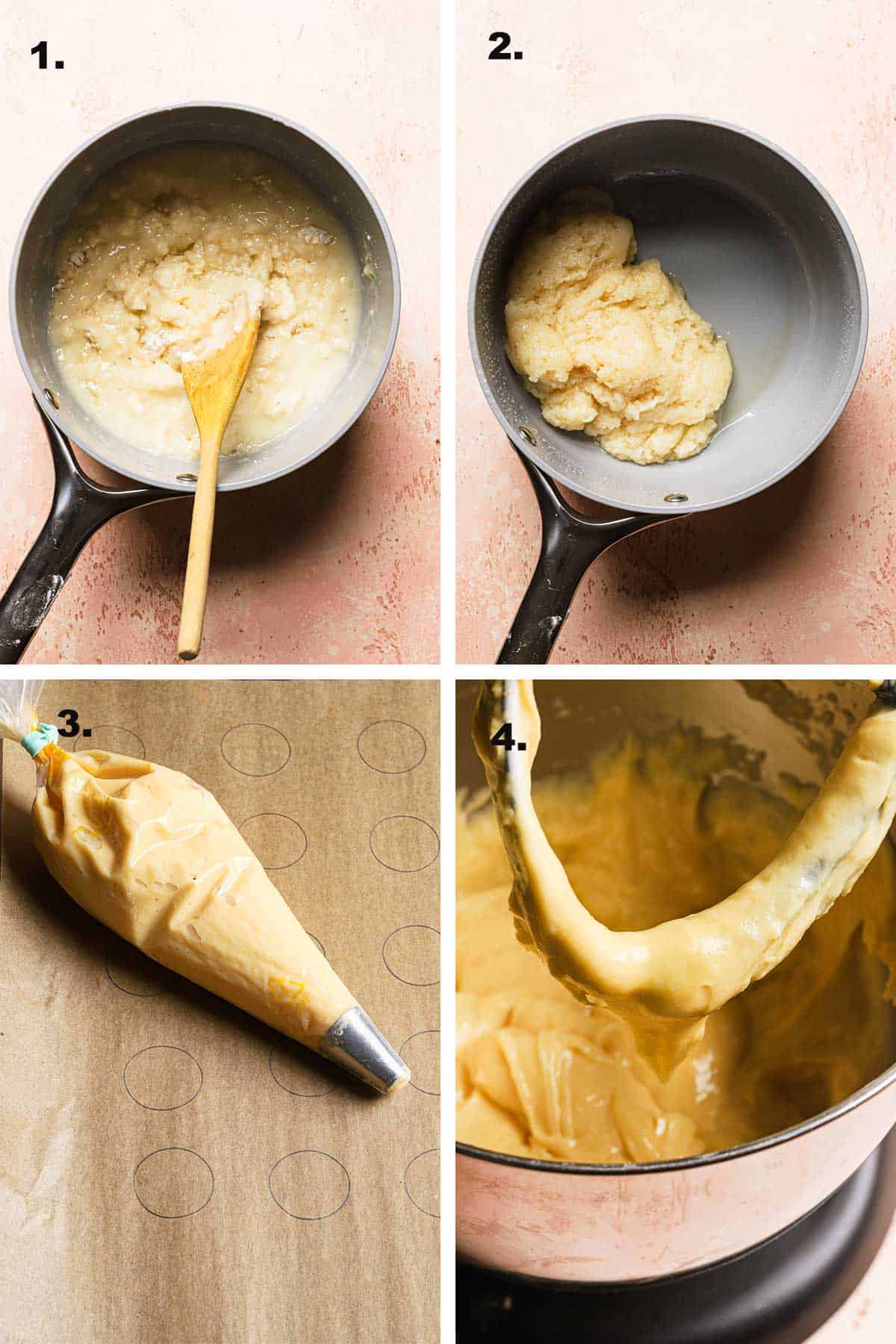
Piping
When piping profiteroles, hold the bag about 1 inch over the pan at a 90-degree angle. Then gently press the dough, and do not move the bag until the dough reaches the tip. Moving the pastry bag up or down will create ruffles and misshape the choux buns.
Topping and finishes
Brushing the pastry pre-bake will add more browning and prevent over-splitting and cracking. Make sure to brush gently; it is excellent when you sprinkle pearl sugar or plan to serve the pastries with no topping, like craquelin or chocolate ganache.
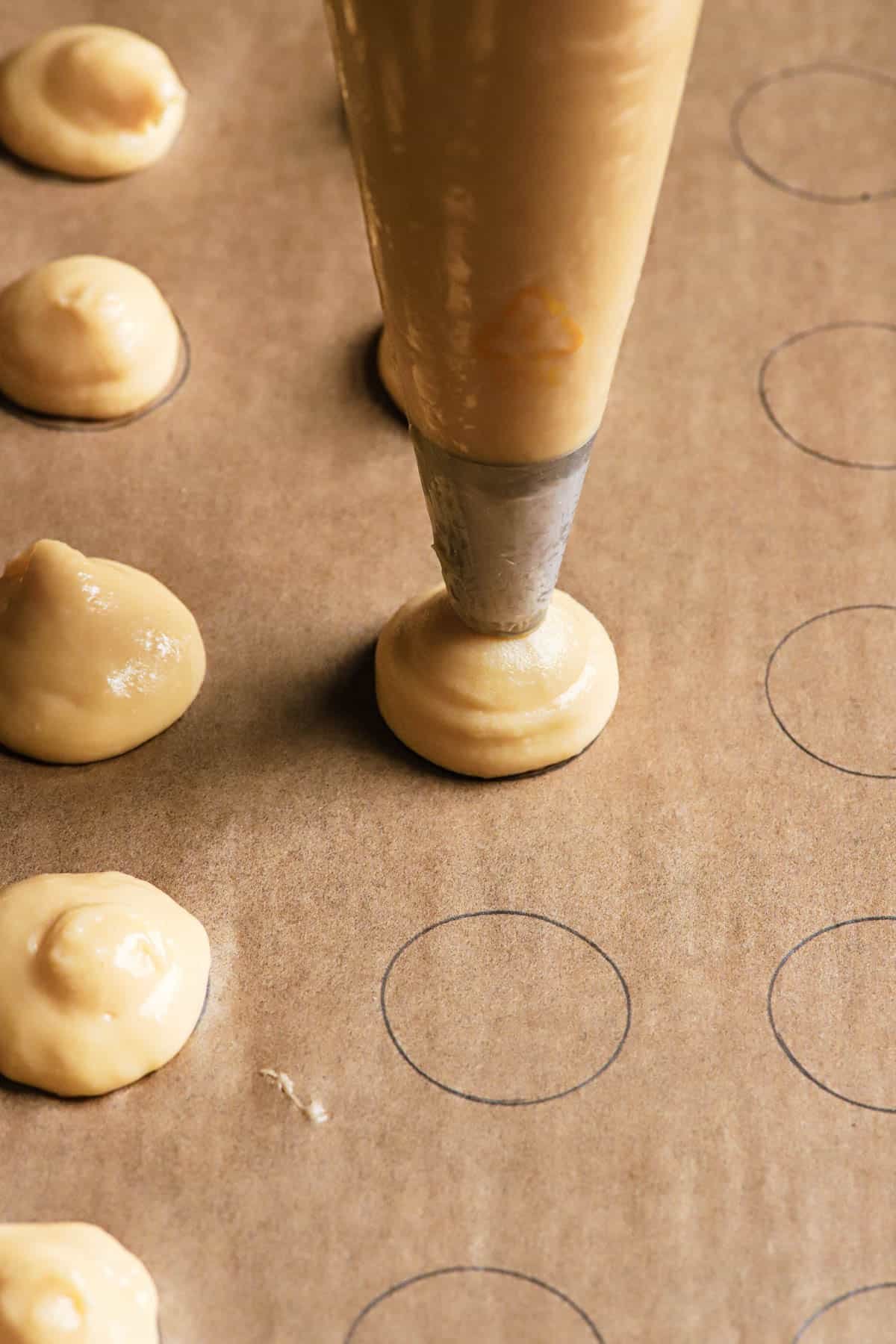
Baking the choux
It is essential to provide enough energy to the dough so the evaporation will create enough pressure to raise the pastry. I like to start at a high temperature of 425F for 10 minutes, then reduce it to 375 for the duration of the bake. This way, the exterior will begin the setting process, but when we reduce the temperature, the pressure is just right to press the shell and evaporate gently.
Of course, it can change from recipe to recipe; eclairs being long and having more exterior surface will benefit from a high temperature for the entire duration of the baking process.
Frying and poaching the choux
To fry the choux when making crullers and churros, ensure the oil temperature is between 360-370F (182-187C). Since the oil temperature is lower than the oven’s, the donuts will be less hollow, which is desirable.
Storing the choux
Empty, store the choux pastries at room temperature covered, for up to three days. Filled, place in the refrigerator for up to 3 days, or according to the filling restrictions.
You can freeze the shells for up to 4 weeks, in a store bag or an airtight container.
Choux Making Tips
I’ve collected the essential tips for the best results, and I recommend carefully reading them before baking.
- Weight the ingredients. Cups and measuring spoons are not as prices as a kitchen scale, and the slightest difference can make or break the pastries.
- Use room-temperature eggs. Cold eggs will not incorporate well, and the pastries will not rise as tall.
- Sift the flour. Small lumps are not easy to distribute, and the paste might be clumpy.
- Use an oven thermometer to ensure your oven is at the right temperature.
- I recommend baking profiteroles, cream puffs on dark baking sheets, choux au craquelin, and eclairs using light ones.
- Do not open the oven door during baking! It will deflate the pastries.
- Let cool in the oven door shut for 10 minutes (don’t open the door), then only crack open for another 20 minutes.
- Keep cool. Especially if this is the first time you are baking choux pastry, it might take one or two attempts before getting it right.
- To make chocolate cream puffs, replace 15% of the flour (10g) with cocoa powder.
Choux Pastry Troubleshooting Guide and FAQ
The panade is very oily.
You cooked the flour mixture long enough for the oil and water to split. That’s ok; it will come together when you add the eggs.
Runny dough that spreads too much
Here are the reasons for the dough to be runny and how to fix it:
- You needed to add more flour. Use a kitchen scale to weigh the flour.
- You should have cooked the panade longer. Use a kitchen thermometer or cook for an extra minute over low heat.
- Too much egg. Firstly, weigh the eggs, add them in three or four parts and do the V test before adding the last portion.
The choux is too thick.
Same reasons and fixes and when it is too thin but the opposite way:
- You added too much flour. Use a kitchen scale to measure it before adding.
- You overcooked the panade, and as a result, the starches coagulated, and a lot of the moisture evaporated. Use a thermometer or pay attention to cook it only for a short time.
- Not adding enough eggs. Add a drip (teaspoon) or beaten egg until you get the right consistency.
The pastry is deflated/collapsed.
You opened the oven door mid-baking or took them out too soon. Do not open the oven door and allow the pastries to cook in the oven. The door shut or slightly open.
Pastries did not puff.
- The oven temperature was too low or too high. Use an oven thermometer to ensure the correct temperature, then increase or decrease the temperature.
- Too much salt. Either skip the salt or pay attention when adding (should not be more than 0.1% of the amount of flour)
The Pastries are not hollow inside.
There are a few reasons why this might happen:
- The oven temperature was too high, and the pastries were set before they could puff. Reduce the oven temperature, and bake on the middle oven shelf.
- Too much moisture. Measure the amount of liquid and eggs, and cook the panade correctly.
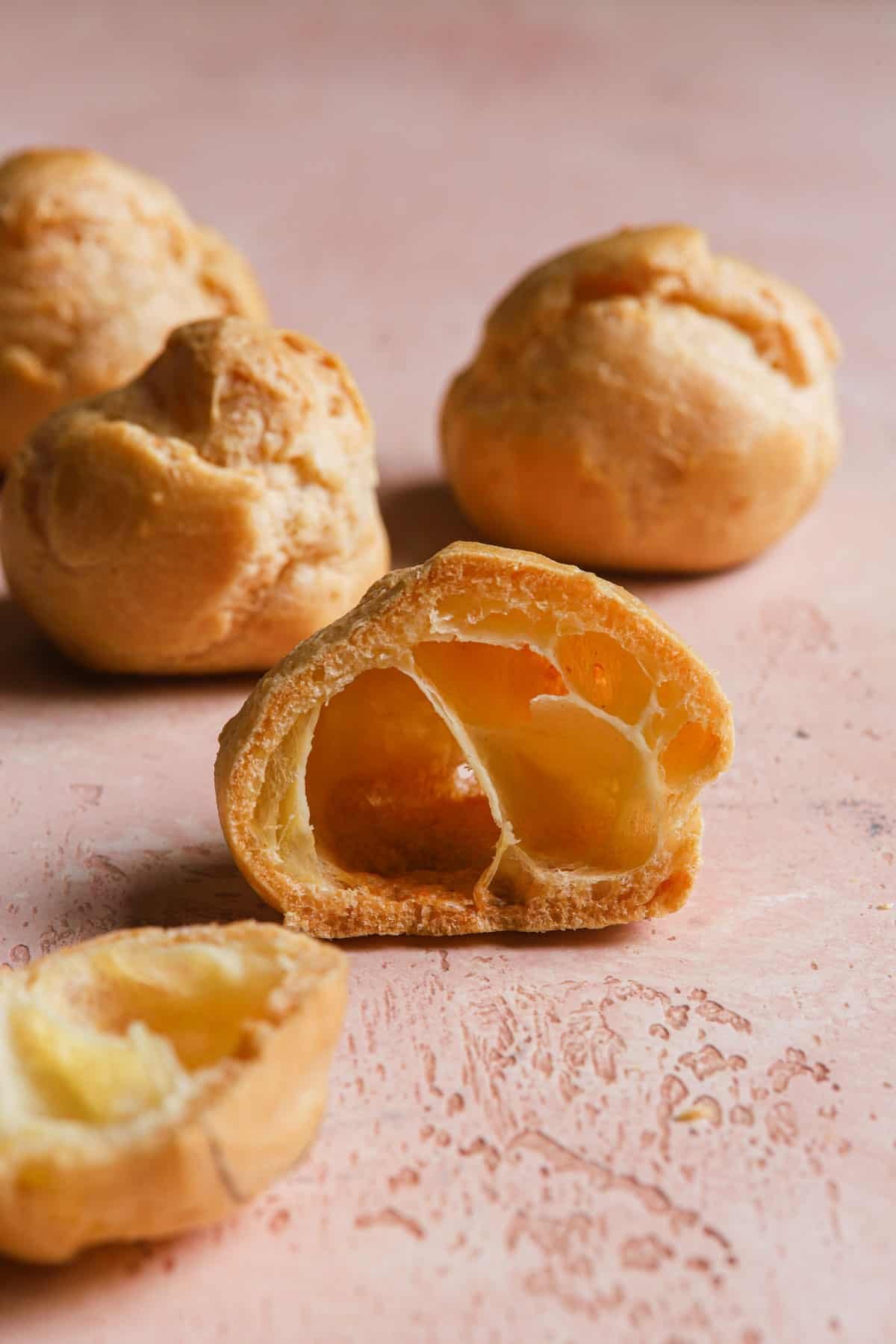
Check out these recipes for some Choux pastry filling ideas
Boston cream donuts (pastry cream), Chocolate ganache, Brioche donuts (chocolate cream), Bavarian cream donuts (Bavarian cream).
Choux pastry recipe
Equipment
- 1 Medium of large pan
- 1 wooden spoon
- 1 large bowl
- 2 large baking sheets
- 2 pieces of parchment paper
- 1 Large piping bag
Ingredients
- 1 Cup Lukewarm water (240ml/225g)
- 1/8 teaspoon Salt
- 1/2 Cup Unsalted butter, cut into 1-inch pieces (113g/4oz)
- 1 Cup Sifted bread flour, or unbleached all-purpose flour (113g/4oz)
- 4-5 Large Eggs, at room temperature (225g/8oz)
Instructions
- Preheat oven to 400F (204C) and line two large baking sheets with parchment paper.
- In a medium saucepan over medium heat, bring the water, salt, and butter to a boil. Make sure the butter is fully melted.
- Remove from the heat, and add the flour. Use a wooden spoon to hydrate the flour, then place it back over the stove.
- Keep stirring as you cook the panade until reaches 175F (79C), or until a soft dough forms.
- Remove from heat and place in a large bowl or a bowl of a stand mixer. Mix using the paddle attachment or a spoon until cool.
- Add the eggs in four additions, each about 2oz/60g, or one egg.
- Once you add the last portion of the eggs, stop the mixer and lift the whisk/ paddle attachment. If the dough falls down in a v shape, then it is ready. If not, add some more eggs and test again.
- Fill a large piping bag fitted with a round tip, and pipe 2-inch rounds leaving at least 2 inches space between each round.
- Bake for 10 minutes at the low (but not the lowest) oven shelf, then reduce the temperature to 375F (190C) and bake for additional 12 minutes.
- Do not open the oven door and turn it off, leave the pastries in the oven to cool for 15 minutes.
- Crack open the door, and allow the pastries to cool for another 20 minutes.
- Remove from the oven, and fill.
Notes
- Make sure all of the ingredients are at room temperature.
- Use a kitchen scale to measure the ingredients.
- Use a 2-inch cookie cutter and a pencil to trace rounds over the parchment paper, then turn it over.
- Check your oven’s temperature using an oven thermometer.
- Do not open the oven door during baking.
- Store empty shells at room temperature for up to five days, covered.
- Filled pastries should be stored in the refrigerator for up to three days.
- You can freeze the shells for up to four weeks in a freezer bag or an airtight container.

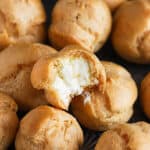

I enjoy your recipes and the details you provide thank you
Nick